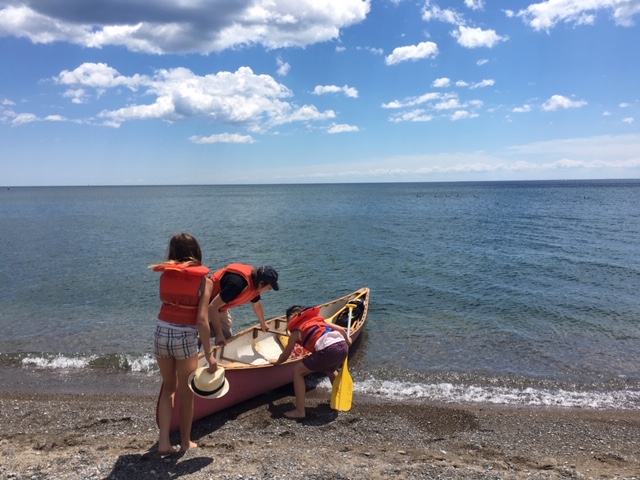Tips and ideas to help introduce children to the wilderness canoeing
By Outdoor Adventure Canada
So often I hear about people giving up canoeing when they have children. When we were expecting the arrival of our son I thought we were going to join the ranks of parents waiting for the children to get older before taking them on a canoe trip. Canoeing does not end for parents of young children and there is no need to send them to the grandparents in order to go tripping. It does change though; here are some tips and tricks to make canoeing a family event.
Properly fitted life jacket
First of all you’ll need to make sure the child has a properly fitted life jacket. There are even models available for children that are under a year old. You should let your child wear the life jacket in a controlled environment such as a pool so that they can learn to lie back with the jacket on. This way they will get used to the feeling and are less likely to panic if you ever do capsize.
Accustomed to the feeling of being in a canoe
Take a few day trips to ensure that they are accustomed to the feeling of being in a canoe. Very young children often like the motion and they find it relaxing. Our son would often fall asleep in the canoe. Small children, under the age of six, should be carried in and out of the canoe so that they don’t cause the boat to tip. Then you might want to do a canoeing trip or two where you are fairly close to civilization until you know that they are comfortable.
Own paddle
For school age children it is fun for them to have their own paddle. You can pick one up at most outdoors stores for under twenty dollars. Even if they only paddle for a ten minutes at a time the little ones really feel proud of paddling. When our little boy isn’t paddling he sits in front of the stern paddler, usually his Dad, on a canoe seat. He plays with small toys and sometimes even falls asleep. He has his own map, compass and binoculars to play with too.
Plan portaging careful
In the beginning you’ll want to make sure there aren’t any really long portages on your trips. If your child is an infant you’ll have to plan portaging careful. Most parents I know use a backpack designed for carrying a child. One person is responsible for the baby and the other(s) take care of the gear. With children aged four and up it is a little different. We’ve taken nieces, nephews and our own boy canoeing and it amazes me how much the kids embrace portaging. We take frequently stops to looks at plants, bugs, mushrooms, rocks and such and I think it is this exploration approach that seems to make the portages fun.

Backyard camping
If they have never been camping before it would be a good idea to set the tent you will use up in the backyard or go camping close to home so that the child can get used to sleeping in a tent and in the outdoors.
Campsite safety
Campsite safety is often a concern. Many times you can eliminate many of the potential hazards by merely choosing the right campsite. Sometimes things happen and you end up with a site that is less than ideal. This happened to us on occasion. One particular island site had a very cliffy side. We brought the canoe up and laid it parallel to the shore on the cliff side and instructed our little one that he was not to go beyond the canoe. You can also use marker tape to section off an area. This works well with school-age children but not so well with toddlers who are more adventurous.
Tying a rope between two trees
In the book Cradle to Canoe the authors, Rolf and Debra Kraiker, recommend a tether system made by tying a rope between two trees that are in a safe spot on the campsite and using a second section of rope with a carabiner attached to each end. One of the carabiners is attached to the main rope and the other to the child’s life jacket. Then you put the life jacket on the child and this keeps the little one out of trouble. Remember that you still have to keep a close eye on the child but this does make it easier to start camp chores.
Biting bugs
Biting bugs can also be an issue. I don’t recommend using adult strength DEET on a child. In fact I prefer to use children’s strength DEET as little as possible. Bug hats and jackets are much better, as well as long-sleeved shirts and pants. If the bugs are bad tuck their pants into their socks.
Rainwear is important
Rainwear is important. It seems to rain on every single one of our trips. Have a raincoat or anorak for the child along with rain pants. A pair of rubber boots is a good idea too. You’d be amazed what neat things you can find by exploring camp on a rainy day. Keeping warm and dry is paramount though.
First aid is important.
I make sure I have all the standard first aid items in my pack but I also bring some Batman band-aids and such. For some reason the hurt seems lessened when they have a fancy band-aid on it. I also pack electrolyte replacement crystals and a children’s pain reliever.
Bedtime
Bedtime can sometimes be difficult. Our little guy was afraid of the dark. One of our friends brought along the neon bracelets and other neon items that you can find at the dollar store. These were amazing. Not only was he more visible but at bedtime we hung the neon item from the gear loft in our tent and it acted like a night light. I was usually the one responsible for bedtime so I would go into the tent and tell him a story or if my imagination wasn’t all that great I would let him look at the images on the screen of the digital camera, We’d talk about the photos and the trip and then he would go to sleep.
Don’t be afraid to take your children on interior canoe trips just tailor the trip to the child’s ability and keep in mind that you will be creating wonderful memories as a family. As the child becomes more skilled you can make the trips more challenging.
If you have any questions please pop into Outdoor Canada Adventure where there are many like people who can offer suggestions and ideas. Outdoor Canada Adventure, bringing adventures to life








